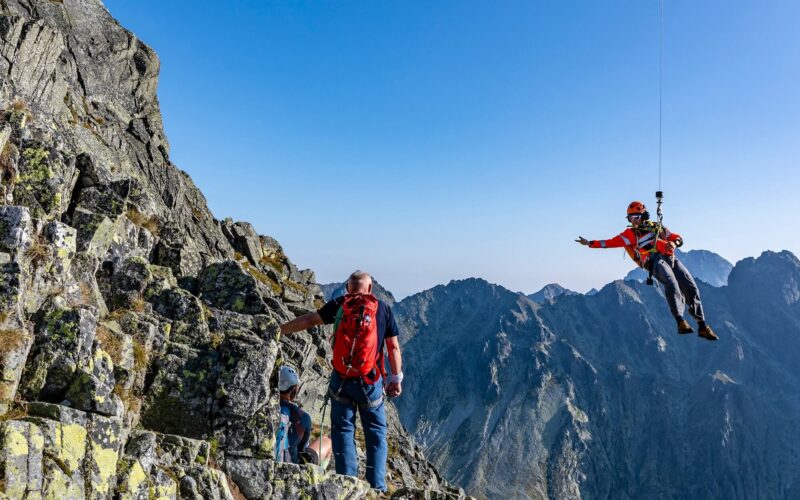They used to be the stuff of science fiction. But thanks to technological advances, jetpacks, devices with back-mounted engines and handheld controls, have become a reality.
However, these flying machines, sought after by some for recreation and extreme sports, may also be suitable for search and rescue operations. In fact, a number of mountain rescue crews have already begun implementing jetpack technologies.
Categories of jetpacks
In order to consider whether a jetpack could be used to rescue people, it is important to look at the machine’s design features.
Depending on the nature of the power required, jetpacks can be divided into three categories: hydrogen peroxide-powered rocket packs, hydrojet packs, and turbojet packs.
When it comes to hydrogen peroxide-powered rocket packs, the technology used is considered to be one of the oldest. These rocket packs are powered by hot gas which results from a chemical reaction when nearly pure hydrogen peroxide meets a catalyst, usually silver. Due to the exothermic reaction, a mixture of steam and hot gas is released, which is then directed into the rocket pack’s nozzles to create a thrust that lifts the device off the ground.
Meanwhile, hydrojet packs are designed slightly differently. The technology used to power hydrojet packs is similar to that used on a jet ski. It features a jet propulsion engine, which has an impeller that uses rotating fan blades to suck water into the engine and then forcefully eject it. Water is used as a high-density propulsion fluid which is supplied via a long flexible hose to feed the water to the jet nozzle pack attached to the pilot’s body. A hydrojet pilot can control water flow rate using a remote actuator or a throttle.
Unlike hydrojet packs, turbojet packs are equipped with wings and an engine fueled with standard kerosene-based jet fuel. However, this design is regarded as the most complex and so it is not as popular as other technologies used to power a jetpack.
Helicopters vs jetpacks for mountain rescue
Could jetpacks replace helicopters and other aircraft traditionally used to perform all-weather search and rescue operations?
Typically, mountain rescue involves local mountaineers and hill walkers as well as professionally trained rescue professionals and aircrew who provide search and rescue helicopter (SAR) responses to emergency situations. The most common air vehicle used for mountain rescue activities is the SAR helicopter, which is usually equipped with crampons installed onto so-called ‘ice skates’ which help the craft to remain stable upon takeoff or landing in extreme weather conditions such as snow and ice.
Another benefit of helicopter usage for mountain rescue is that the aircraft are usually equipped with medical equipment, including defibrillators, intravenous infusion sets, and comprehensive resuscitation kits as well as portable suction units and medical kits for critical patients. These helicopters can also feature additional medical equipment including chest drainage equipment, intubation equipment, amputation sets, and patient immobilizing kits.
So, what’s the argument for using jetpacks?
Because of a jetpack’s ability to reach average speeds of more than 130 kilometers per hour (or around 80 miles per hour), rescuers could use single-pilot flying machines when an immediate response is essential. Unlike helicopters, jetpacks feature a high level of maneuverability that allows rescue crews to get to people who need medical help in hard-to-reach areas.
For instance, paramedics of the UK-based Great North Air Ambulance (GNAA) have been testing the British inventor’s Richard Browning jet suit called the Daedalus Flight Pack. The jetpack can produce up to 144 kilograms (317 lbs) of thrust at full throttle from a pack of high-discharge LiPo batteries, so it can ascend quickly and save time in case of emergency.
The jet suit features five small engines: two engines on each arm of a pilot as well as one which is attached to the pilot’s back. This technology allows the paramedic to control the jetpack by moving their hands and allows them to conduct short flights at low altitudes.
Paramedics from the GNAA have estimated that it could take up to 90 seconds for a jetpack pilot to reach a patient in an area where it would take up to 30 minutes to land with a helicopter. And even though a flying paramedic couldn’t carry the same amount of medical equipment as a helicopter, a jetpack pilot is able to bring between 10 and 15 kilograms (22 to 33 lbs) of first aid supplies, including a medical kit with pharmaceuticals, a defibrillator and other patient-monitoring devices.
The lack of legal regulations
But if it is possible for a jetpack pilot to carry medical equipment, why are these flying machines not yet widely used for mountain rescue operations?
Even though UK paramedics were among the first to initiate trials of jetpacks, there are currently no legal regulations covering such operations in Europe or the United States, making it essentially illegal to fly jetpacks for rescue operations.
Another major issue to solve before jetpacks could be widely deployed for search and rescue is the high cost of operating and maintaining the technology. For example, the price for the Daedalus Flight Pack stands at around $440,000 per unit. The jetpack also burns approximately three liters (or a gallon) of jet fuel per minute, which makes it expensive to operate.
It is also important to consider the safety aspect. A jetpack does not feature proper safety equipment to protect the pilot in case of an incident or technical malfunction. Since such a device falls into an experimental category of aircraft, a person willing to fly a jetpack has to complete flight training to hold a Light Sports Aircraft (LSA) pilot certificate. This suggests that in the future paramedics may be also required to complete specific training before flying to rescue missions.

